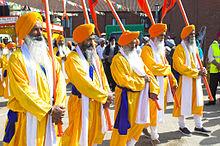পঞ্চ প্রিয়

| শিখধর্ম |
|---|
 |
পঞ্চ প্রিয় (গুরুমুখী: ਪੰਜ ਪਿਆਰੇ, পাঞ্জ পেয়ারে, পাঁচ প্রিয়জন) বলতে শিখ ধর্মের অনুসারি খালসা শিখদের একত্রে সমবেত পাঁচ অমৃতধারী (বাপ্তিস্মপ্রাপ্ত) পঞ্চককে বুঝায় যারা বৃহত্তর শিখ সম্প্রদায়ের প্রাতিষ্ঠানিক নেতা হিসাবে কাজ করে।[১][২][৩]
কর্মকাণ্ড
[সম্পাদনা]পঞ্চ প্রিয়গণ স্থানীয় এবং আন্তর্জাতিক উভয় ধরণের বিষয়ে শিখ সম্প্রদায়ের হয়ে মতামত ও বক্তব্য উপস্থাপন করে থাকে।[৩] পঞ্চ প্রিয়ের এই পঞ্চকদেরকে সম্প্রদায়ের সদস্যদের মধ্য হতে মেধার ভিত্তিতে নির্বাচিত করা হয়।[৩]
উত্সব
[সম্পাদনা]
তারা নগর কীর্তন মিছিলের নেতৃত্ব দিয়ে থাকেন।[৪] শিখধর্মের খালসা ক্রমে নতুন সদস্যদের বাপ্তিস্ম দেওয়ার অমৃত সঞ্চার অনুষ্ঠান পরিচালনার জন্যও পাঞ্জ পেয়ারেদের আবশ্যক।[১] ১৬৯৯ খ্রিস্টাব্দের ভৈশাখী পর্যন্ত শিখ দীক্ষা অনুষ্ঠানটি চরণ পাহুল নামে পরিচিত ছিল।[৫] তাদেরকে নবনির্মিত গুরুদ্বারগুলির ভিত্তিপ্রস্তর স্থাপনের কাজে যুক্ত থাকতে হয়।[৩]
ঐতিহাসিক ব্যবহার
[সম্পাদনা]ঐতিহাসিক অর্থে, ১৬৯৯ সালের ৩০ মার্চ তারিখে ভারতের পাঞ্জাব অঞ্চলের আনন্দপুর সাহিবে অনুষ্ঠিত ঐতিহাসিক এবং স্মারক সমাবেশে এই শব্দটি দশম শিখ গুরু গুরু গোবিন্দ সিং - ভাই দয়া সিং, ভাই ধরম সিং, ভাই হিম্মত সিং, ভাই মোহকাম সিং এবং ভাই সাহিব সিং - এই পাঁচজনকে বুঝাতে ব্যবহৃত করেন। (গ্রেগরিয়ান ক্যালেন্ডার ১৭৫২ সালে ১১ দিন এড়িয়ে যায়। তাই, বর্তমান সময়ে, বৈশাখী প্রতি বছর ১৩ এপ্রিলের কাছাকাছি হয়।)
লিঙ্গ
[সম্পাদনা]যেহেতু প্রথম পঞ্চ প্রিয়ের পঞ্চকটি যেটি গুরু গোবিন্দ সিং নিজেই নিযুক্ত করেছিলেন তাতে তিনি কেবল পুরুষদেরকেই নিয়েছিলেন ফলে অনেক শিখ বিশ্বাস করেন যে পঞ্চ প্রিয় শুধুমাত্র পুরুষদের নিয়ে গঠিত হতে হবে এবং মহিলাদেরকে প্রতিনিধি হিসাবে দীক্ষিত করা হবে না।[৪] যাইহোক, এটি শিখ বিশ্বাস এবং লিঙ্গ সমতার অনুশীলনের বিরুদ্ধে বলে অভিমত দেয়া হয়।[৪] তবে, শিখদের থ্রিএইচও সম্প্রদায় বাপ্তিস্মপ্রাপ্ত শিখ মহিলাদেরকেও পঞ্চ প্রিয় হিসাবে অন্তর্ভুক্ত করাকে অনুমোদন করে।[৪]
আরও দেখুন
[সম্পাদনা]টীকা
[সম্পাদনা]পু্স্তকপঞ্জী
[সম্পাদনা]- "Concepts in Sikhism"। Global Sikh Studies [www.globalsikhstudies.net]। ফেব্রুয়ারি ২৩, ২০০৯ তারিখে মূল থেকে আর্কাইভ করা। সংগ্রহের তারিখ এপ্রিল ৪, ২০০৬।
তথ্যসূত্র
[সম্পাদনা]- ↑ ক খ Williams, Victoria (২০১৬)। "Dastaar Bandi and Amrit Sanchar, Sikhism"। Celebrating life customs around the world : from baby showers to funerals। Santa Barbara, California: ABC-CLIO। পৃষ্ঠা 70। আইএসবিএন 978-1-4408-3658-9। ওসিএলসি 956633929।
During the ceremony the amrit is accompanied by a solemn oath in the presence of Sri Guru Granth Sahib and Panj Pyare, or the five beloved ones. Panj Pyare is a quintet of initiated Sikh men or women that act as leaders within the Sikh community. The Panj Pyare oversee the Amrit Sanchar ceremony by preparing the initiates and administering the amrit to those ready to be initiated
- ↑ Singh, Jaspal (২০২১)। Guru Granth Sahib: The Sikh Scripture। K.K. Publications। পৃষ্ঠা 62।
- ↑ ক খ গ ঘ Sandhu, Gian Singh (২০২৩)। "34. Who are the current panj pyare?"। Who Are the Sikhs? An Exploration of the Beliefs, Practices, & Traditions of the Sikh People.। Archway Publishing। আইএসবিএন 978-1-6657-3953-5। ওসিএলসি 1376370414।
Today, the term panj pyare refers to an ad hoc group of five amritdhari Sikhs who are recognized by the congregation for their commitment to Sikhi and are asked to perform certain functions. The panj pyare are given the honour of conducting the amrit sanchar (initiation ceremony) and may also be called upon to perform other important services, such as laying the cornerstone of a gurdwara or leading a religious procession. They may also assist in dispute resolution, such as deciding issues confronting a family, the local Sikh sangat (community), or the greater Sikh panth as a whole. They must be of the highest moral standing and adhere strictly to Sikh principles and values. The panj pyare are all volunteers, and they are selected when the need arises. They maintain this status until the duty they were asked to perform has been fulfilled.
At crucial moments of Sikh history, the panj pyare have collectively acted as supreme authority for the Sikhs. For example, during the battle of Chamkaur, the last five surviving Sikhs constituted themselves into the Council of Five, and they commanded Guru Gobind to leave the fortress and save himself to reassemble the Sikhs. Before Guru Gobind Singh passed away, he ended the line of living gurus. Through the institution of the panj pyare, the Guru envisioned a continuing society that would conduct itself democratically and choose its leaders based on merit. - ↑ ক খ গ ঘ Jhutti-Johal, Jagbir (২০১১)। "Sikhism and Women: Khalsa Women – Panj Pyare"। Sikhism Today। London: Bloomsbury Publishing। পৃষ্ঠা 49। আইএসবিএন 978-1-4411-8140-4। ওসিএলসি 721194810।
- ↑ "Charan pāhul | The Concise Oxford Dictionary of World Religions"। www.encyclopedia.com। সংগ্রহের তারিখ ২০২২-০৯-২৪।
Charan pāhul (Pañjābī, ‘foot-initiation’). Hindu initiation ritual continued by Sikh Gurūs. Gurū Gobind Siṅgh replaced charan pāhul with khaṇḍe-dī-pāhul, initiation with the khaṇḍā on Baisākhī day 1699.
- Singh, Patwant (১৯৮৯)। The Golden Temple। South Asia Books। আইএসবিএন 962-7375-01-2।